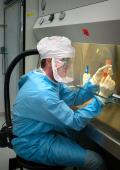H5N1 infection explored

Bird flu triggers high and sustained virus buildup, cause of severe disease
15:13:05 EDT Sep 10, 2006
Canadian Press: HELEN BRANSWELL
(CP) - The severe disease that H5N1 avian flu provokes in people appears to be caused by the virus's ability to replicate at unusually high levels for a prolonged period - an overwhelming assault that triggers a massive and devastating immune system response, a new scientific paper suggests.
Interrupting that process before it reaches the tipping point is critical, say the authors of the article, who based their observations on detailed study of 18 H5N1 patients in Vietnam.
But experts unrelated to the research wonder whether the current anti-flu arsenal - mainly neuraminidase inhibitors such as Tamiflu - is equipped to do that job.
"The question I worry about is whether treating patients now with neuraminidase inhibitors may be very much like shutting the barn door after the horse is already out," said Dr. Michael Osterholm, director of the Center for Infectious Diseases Research and Policy at the University of Minnesota.
"I don't know that. But we've got to find that out."
The World Health Organization is in the process of setting up a research network across countries afflicted with H5N1, in the hopes that joint studies will answer questions like the one Osterholm poses.
Dr. Frederick Hayden, an antiviral expert who heads the effort, said the first task will be to investigate whether different dosing regimes for Tamiflu might achieve better results.
As well, the group hopes to look at whether a flu drug that could be administered intravenously would be more effective at combating H5N1 infection. Injectable forms of two drugs - peramivir and zanamivir - are in development.
"A potent parenteral (injectable) agent ... is really needed and will give us the ability, I hope, to more rapidly control replication in patients with these kinds of severe infections," Hayden said.
The paper, to be published Monday in the journal Nature Medicine, is the first detailed record of the disease process or pathogenesis of H5N1 in humans. The observations are based on 18 H5N1 patients who were treated in Vietnam during 2004 and 2005. Thirteen of them died.
The researchers charted the way H5N1 replicated in those cases and how their immune systems responded. The massive amounts of virus generated triggered production of excessive levels of some chemokines and cytokines, chemicals used to attract white blood cells - the body's cleanup crew - to the site of infection.
This hyperactive immune response - called a cytokine storm - actually does more damage than it sets out to fix. And scientists aren't clear on how to suppress the damaging parts of that process without disabling the immune system's ability to fight the virus.
Lead author Dr. Menno de Jong suggested the key is early treatment with antivirals, perhaps combined with drugs that modify the immune response.
"The paradigm 'Hit hard and hit early' which has been used for treatment of HIV-AIDS in the past may well be very true for the treatment of avian flu," said de Jong, a physician and virologist with Oxford University's Clinical Research Unit at the Hospital for Tropical Diseases in Ho Chi Minh City.
"Considering the likely role of the immune response in causing damage during the later stages of infection, it obviously makes sense to think about the use of anti-inflammatory or immune-modulatory treatment," he said in an e-mail interview.
"However, we still know relatively little about which part of the immunological cascade is best targeted and how to target this."
The director of the U.S. National Institutes of Allergy and Infectious Diseases said more needs to be known about the way the virus interacts with a human host. That could shed light on when antiviral drugs would have maximum impact on replication and the cytokine storm phenomenon, Dr. Anthony Fauci said in an interview.
But finding that optimal point may not be easy, he suggested, because influenza replication typically peaks as people are becoming symptomatic and the immune response is already kicking into gear.
"To me that's almost a catch-22," Fauci said.
"Because if you know the person is infected and has virus replication only when they become symptomatic, then depending on how long that peak lasts, will you or will you not be able to have a substantial impact on it by (administering) antivirals?"
Osterholm for one is pessimistic on that count, suggesting neuraminidase inhibitors like Tamiflu may be better suited to preventing H5N1 infection rather than treating the ensuing disease once it's apparent someone is infected.
If that's true, he advocates stockpiling the drugs to protect health-care workers and keep hospitals operational during a pandemic rather than using the drugs for treatment, as the pandemic plans of many countries - including Canada - currently stress.
De Jong's paper also clearly underscores the differences between the disease provoked by H5N1 and that caused by human flu strains.
It notes, for instance, that swabbing the pharynx to look for virus is a more effective way to diagnose H5N1 than taking a nasal swab. With human flu strains, the reverse is true.
The researchers also found traces of the virus in the blood and rectum of critically ill patients. While that could be a hint the virus replicates in organs outside the respiratory tract and the lungs, it isn't proof positive, de Jong said.
Autopsies of H5N1 patients would needed to determine that, he and others said. But because of cultural objections, autopsies have been performed on fewer than a handful of the 143 people known to have died of H5N1 so far.


0 Comments:
Post a Comment
Subscribe to Post Comments [Atom]
<< Home